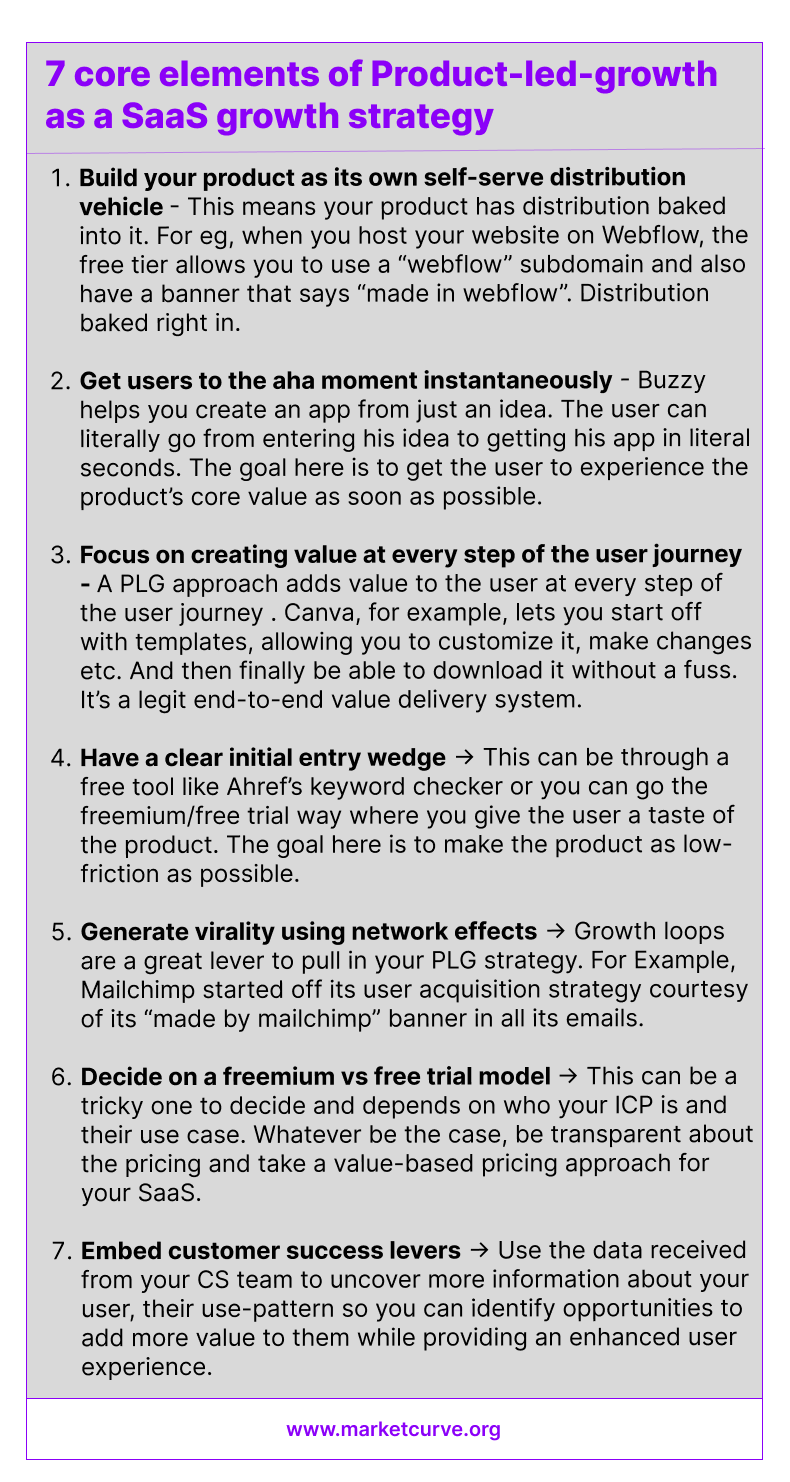Hey friends, in today’s issue, we discuss the 7 strategies you can experiment with to grow your SaaS using a product-led-growth approach. All in less than 250 words. Let’s dive in, shall we?
Brought to you by:
Friends,
Product led growth is when you leverage your product to acquire, activate, convert, retain, and monetize your users.
In PLG, your product is not only the set of features that solve customer pain points but also your go-to-market (GTM) motion, and your distribution and engagement channel.
Here are 7 strategies you can execute to put your Product-led-growth in motion
Build your product as its own self-serve distribution vehicle - This means your product has distribution baked into it. For eg, when you host your website on Webflow, the free tier allows you to use a “webflow” subdomain and also have a banner that says “made in webflow”. Distribution baked right in.
Get users to the aha moment instantaneously - Buzzy helps you create an app from just an idea. The user can literally go from entering his idea to getting his app in literal seconds. The goal here is to get the user to experience the product’s core value as soon as possible & get them to the aha moment fast. Having a clean product UX is key here.
Focus on creating value at every step of the user journey - A PLG approach adds value to the user at every step of the user journey . Canva, for example, lets you start off with templates, allowing you to customize it, make changes etc. And then finally be able to download it without a fuss. It’s a legit end-to-end value delivery system.
Have a clear initial entry wedge → This can be through a free tool like Ahref’s keyword checker or you can go the freemium/free trial way where you give the user a taste of the product. The goal here is to make the product as low-friction as possible.
Generate virality using network effects → Growth loops are a great lever to pull in your PLG strategy. For Example, Mailchimp started off its user acquisition strategy courtesy of its “made by mailchimp” banner in all its emails.
Decide on a freemium vs free trial model → This can be a tricky one to decide and depends on who your ICP is and their use case. Both models can work depending on your product, your users and other variables. Whatever be the case, be transparent about the pricing and take a value-based pricing approach for your SaaS.
Embed customer success levers → Use the data received from your CS team to uncover more information about your user, their use-pattern so you can identify opportunities to add more value to them while providing an enhanced user experience.
Take a screenshot of your GrowthShot
Attract & close high-intent buyers from your SaaS landing page
99% of startups fail because they fail to find product-market fit. Especially in the early days when you’re spread thin between building out your product & talking to customers. Both of which are non-negotiables.
Your landing page is the first thing that prospects see when they land on your page. Your copy needs to communicate your value prop effectively & target their pain points and how your solution helps them.
Copywriting is more than just words. It’s sales. And you need to invest in a salesman that does the selling for you 24*7 even when you’re asleep.
But who can you trust with this?
Well, the gentleman who left the above review got a before-after version of his landing page (pipl.ai)
He saw a 21% increase in conversion on his page and guess what?
He made $10k in sales for his SaaS. Talk about a high ROI.
Not going to guarantee that this will 100% happen for you too but a man can try :)
Some more examples:
Want to get more users from your landing page? Book a call with me - I’d love to learn more about what you’re building :)
In case you haven’t noticed, I’m a real business nerd









